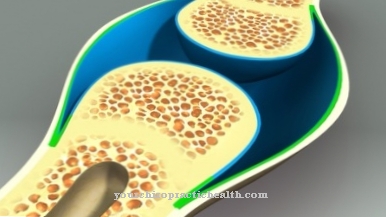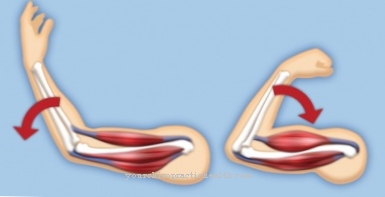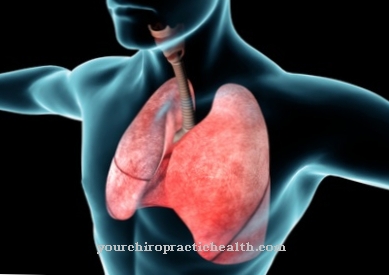Of the cerebral vascular resistance is one of the most important parameters in the autoregulation of the cerebral blood flow. It is a flow resistance with which the brain vessels meet the blood flow of the systemic blood pressure. In the case of severe brain damage as a result of trauma, tumors or cerebral haemorrhage, the autoregulation is disturbed.
What is cerebral vascular resistance?

Medicine understands the cerebral vascular resistance as a flow resistance of the brain vessels. The vessels of the brain oppose the blood flow of the systemic blood pressure with the cerebral vascular resistance. They narrow or expand their vessel diameter depending on the systemic blood pressure values. The cerebral vascular resistance is thus a regulating variable in the blood flow to the human brain.
The regulation circuit is a protective mechanism to support life when blood pressure values change. Like all vessels, the cerebral vessels are also equipped with a layer of muscle fibers. This layer of muscle can contract or relax.
Relaxation leads to a vasodilatation with an increase in blood flow. Contraction leads to a narrowing of the blood vessels with decreased blood flow. Since the brain cannot tolerate either too little or too much blood flow, the vessels must react to changes in blood pressure values with regulative relaxation or contraction. In this way, brain damage due to excessive and below-average blood supply can be prevented.
The tissue of the human brain is also the most sensitive and specialized tissue in the human body. Nerve cells in the brain are involved in every human body process. Without the highly specialized brain tissue, humans are therefore not viable. In this way, unlike cardiac death, brain death is equated with actual death. The cerebral vascular resistance prevents this brain death.
Function & task
The blood serves as an important transport medium in the human body and, in addition to essential oxygen, also carries nutrients and messenger substances. The condition of insufficient blood flow means a lack of oxygen and nutrients. All cells in the body are therefore dependent on an adequate blood supply to survive.
In the brain, inadequate blood pressure values are particularly tragic due to the life-sustaining functions of the brain. The human body has various mechanisms to support life. This applies in particular to the area of the brain, which is particularly worthy of protection and vital due to its diverse tasks.
A protective mechanism exists, for example, for cerebral blood flow. If systolic blood pressure values of 50 to 150 mmHg and intracranial normal pressure values are available, the cerebral vessels can respond to changes in mean arterial pressure with adjustments in the vascular resistance.This resistance regulation corresponds to a reaction to keep the cerebral blood flow constant.
The autoregulation of cerebral blood flow is crucial for the adequate blood supply to the brain. This prevents brain damage due to a lack of oxygen or nutrients. The cerebral vascular resistance is directly related to the blood gases. When the CO2 partial pressure within the arterial blood rises, the cerebral vessels react against the background of constant blood pressure values. The blood flow to the brain increases with cerebral vascular dilation.
The same mechanism applies in the other direction. A decreasing CO2 partial pressure in the arterial vessels therefore increases the cerebral vascular resistance. As a consequence, the cerebral blood flow decreases. In this way, the brain is adequately supplied with blood even during hypoventilation and hyperventilation.
Carbon dioxide is the most important factor influencing the vascular resistance of the cerebral vessels. The oxygen partial pressure is a somewhat smaller influencing factor. When the pO2 in the arterial blood falls, the cerebral arteries can widen. But only if there is a lot of waste. In this case, the pO2 drops below 50 mmHg. As a result of the widening, the blood flow to the brain increases due to the changes in resistance within the cerebral vessels. This process is also designed to prevent brain damage due to inadequate blood flow.
Illnesses & ailments
The mechanisms of cerebral vascular resistance do not survive certain situations. Without these mechanisms, the brain is no longer protected from increased and decreased blood supply and the risk of brain death increases. More severe damage to the brain can occur, for example, as part of trauma, cerebral haemorrhage, brain tumors and edema.
On the one hand, these pathophysiological conditions switch off the blood-brain barrier. On the other hand, they affect cerebral autoregulation. The processes of autoregulation can be so severely disturbed within the framework of the named conditions that the cerebral blood flow produces an immediate change in the mean arterial blood pressure. The sensitive nerve cells are damaged in the process.
In addition, the autoregulatory mechanism of cerebral blood flow is overwhelmed at systemic blood pressure values below 50 mmHg and above 150 mmHg. In this case, the autoregulation adapts to the vessel diameter, but can no longer compensate for the abnormal blood flow even through maximum adjustment.
Reduced blood flow leads to ischemia and thus results in a lack of oxygen and nutrients. If the blood flow is reduced by half, full oxygen exhaustion is initiated as an additional compensation mechanism. At values below 20 milliliters per 100 grams per minute, reversible changes in the brain cells occur. If the blood flow is reduced to less than 15 milliliters per 100 grams per minute, nerve cells in the brain die irreversibly within seconds.
Hyperemia is the opposite event, i.e. an excessively high blood flow rate. In the process, the intracranial pressure rises and causes compression-related damage to the brain tissue. In hypertensive crises, the upper limit of autoregulation is exceeded and brain edema occurs. Persistent high blood pressure also pushes the limits of autoregulation upwards.




























